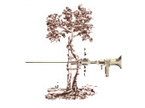“Sit up straight!” “Don’t slouch!” I’m sure we’ve all heard those admonishing words more than once from our mother when we were growing up. And most of us begrudgingly complied with her command having no concept of the anatomical and biomechanical rationale behind her persistent prodding. In fact she probably wasn’t aware of all the implications of poor posture herself! But somehow, some way your mother always seemed to know best.
What is good posture anyway and why is it so important? Basically posture refers to the body’s alignment and positioning with respect to the ever-present force of gravity. Whether we are standing, sitting or lying down gravity exerts a force on our joints, ligaments and muscles. Good posture entails distributing the force of gravity through our body so no one structure is overstressed.
An architect has to take these same laws of gravity and weight distribution into account when he or she designs a building. And like a building with a poor foundation a body with poor posture is less resistant to the strains and stresses we experience over the months, years and decades of life.
When doctors or therapists look at someone’s posture they generally first look at the alignment of the weight bearing joints in standing. Ideally from a back view the spine should have no lateral curvature and the legs should be symmetrical without undue angulation at the knees or ankles. From a side view the spine should form a smooth S-shaped curve, bisected by an imaginary plumb line dropped from the apex of the head through the center of gravity of the body. This same plumb line should pass through the tip of the shoulder, the center of the hip joint and ankle joint and slightly behind the knee joint. With this ideal alignment the body weight is balanced over the spine and lower extremity joints requiring minimum muscular effort. This alignment also evenly distributes pressure on the intervertebral discs and avoids excessive stress on the ligaments.
The sitting position is where most of us get into trouble with poor postural habits. This is especially true when driving or using a computer. As we focus on the activity in front of us we tend to protrude the head and neck forward. Because the body follows the head, the thoracic and lumbar spine tends to round forward as well. When this occurs, the weight of the head and upper body is no longer balanced over the spinal column but instead must be supported by increased muscular energy and placing spinal ligaments on stretch. Over time this leads to fatigue and eventually even pain in the neck and upper back. Shoulders rounded forward which occurs for example when your car seat is too far away from the steering wheel further contributes to this pattern of imbalance. Ideally then, the S-shaped curvature of the spine that is characteristic of good standing posture should be maintained in sitting as well. This is best accomplished by sitting all the way back in a straight-backed chair and placing a folded towel or small pillow in the arch of the low back. Fortunately, many new office chairs and car seats come with built-in lumbar supports and other adjustable features.
Sitting and standing with proper postural alignment will allow one to work more efficiently with less fatigue and strain on your body’s ligaments and muscles. Being aware of good posture is the first step to breaking old poor postural habits and reducing stress and strain on your spine. By putting this knowledge into practice one can prevent the structural anatomical changes that can develop if poor posture is left uncorrected for many years. So to repeat an old adage you may also have heard from your mother: “An ounce of prevention is worth a pound of cure.” Thanks Mom!
P.S. In this discussion we’ve introduced you to some basic concepts of “static” posture like sitting and standing. In a future installment we’ll talk about “posture in motion”, commonly known as body mechanics. Body mechanics refers to how we position our body to perform movement activities like pushing, lifting or carrying. And just like good static posture, “good” body mechanics will allow one to work and play more efficiently and with less stress on any one body part.
Also we encourage you to check out upcoming articles on other topics in orthopedic and sports rehabilitation. For example, we’ll talk about what to do immediately after a joint sprain, and later on, some tips on prevention of carpal tunnel syndrome. Until then, all of us at SCOI wish you good health and healthy living. Thanks for visiting!
Author – FRANK J. D’AMBROSIO, PT


